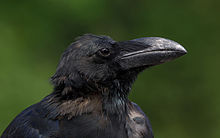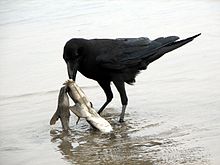Large-billed crow
| Large-billed crow | |
|---|---|

| |
| C. m. japonensis at Tennōji Park in Osaka, Japan | |
| Scientific classification | |
| Domain: | Eukaryota |
| Kingdom: | Animalia |
| Phylum: | Chordata |
| Class: | Aves |
| Order: | Passeriformes |
| Family: | Corvidae |
| Genus: | Corvus |
| Species: | C. macrorhynchos
|
| Binomial name | |
| Corvus macrorhynchos Wagler, 1827
| |

| |
| Range | |
The large-billed crow (Corvus macrorhynchos), formerly referred to widely as the jungle crow, is a widespread Asian species of crow. It is very adaptable and is able to survive on a wide range of food sources, making it capable of colonizing new areas, due to which it is often considered a nuisance, especially on islands. It has a large bill, which is the source of its scientific name macrorhynchos (Ancient Greek for "long-billed") and it is sometimes known by the common name thick-billed crow. It can also be mistaken for a common raven. The eastern jungle crow and Indian jungle crow were once considered conspecific and together called the jungle crow.
Subspecies
[edit]The large-billed crow was formally described in 1837 by the German naturalist Johann Georg Wagler under the current binomial name Corvus macrorhynchos.[2] The type locality is the island of Java.[3] The specific epithet macrorhynchos is from Ancient Greek μακρορρυγχος/makrorrhunkhos meaning "long-billed".[4]
Eight subspecies are recognised.[5] Some are distinctive vocally, morphologically and genetically, leading to treatments that raise some of them into species status.[6][7][8]
- C. m. japonensis Bonaparte, 1850 – central, south Sakhalin, Kuril Islands and Japan
- C. m. connectens Stresemann, 1916 – Ryukyu Islands (southwest of Japan)
- C. m. osai Ogawa, 1905 – south Ryukyu Islands (southwest of Japan)
- C. m. mandshuricus Buturlin, 1913 – east, southeast Siberia, north Sakhalin, Korea Peninsula and northeast China
- C. m. colonorum Swinhoe, 1864 – central, south China, Taiwan, Hainan Island (off southeast China) and north Indochina
- C. m. tibetosinensis Kleinschmidt & Weigold, 1922 – Tibet and the east Himalayas to north Myanmar and south China
- C. m. intermedius Adams, 1859 – Afghanistan and Pakistan through the central Himalayas
- C. m. macrorhynchos Wagler, 1827 – Malay Peninsula, Sumatra, Java and Bali to Romang and Sermata (east Lesser Sunda Islands)
Former subspecies now considered to be distinct species:[5]
- Eastern jungle crow (Corvus levaillantii)
- Indian jungle crow (Corvus culminatus)
- Philippine jungle crow (Corvus philippinus)
Description
[edit]
The overall size (length: 46–59 cm; 18–23 in). Wingspan is (100–130 cm; 39–51 in). Body proportions vary regionally. In the far northeast in Japan, the Kuriles and the Sakhalin peninsula, it is somewhat larger than the carrion crow. All taxa have a relatively long bill with the upper one quite thick and arched, making it look heavy and almost raven-like. Generally, all taxa have dark greyish plumage from the back of the head, neck, shoulders and lower body. Their wings, tail, face, and throat are glossy black. The depth of the grey shading varies across its range.
Distribution and habitat
[edit]
The range of this species is extensive and stretches from the northeastern Asian seaboard to Afghanistan and eastern Iran in the west, through South and Southeast Asia, to the Lesser Sundas and Cambodia in the southeast. It occurs in woodland, parks and gardens, cultivated regions with at least some trees, but is a bird of more open country in the south of its range where it is not in competition with the common raven and carrion crow of the north.[citation needed]
Ecology and behaviour
[edit]Diet
[edit]Extremely versatile in its feeding, it will take food from the ground or in trees. They feed on a wide range of items and will attempt to feed on anything appearing edible, alive or dead, plant or animal. It is also one of the most persistent species and is quite bold, especially in urban areas. In Japan, crows* are considered to be a pest, as they rip open garbage bags and take wire coat hangers for their nests. (*This is likely mis-identification of the gregarious Carrion Crow Corvus corone.) In Sri Lanka, Karunarathna & Amarasinghe (2008)[9] noted that the jungle crow might actually be a, if not the, major predator of local small animals; jungle crows are highly experienced at catching lizards, taking only 45 minutes to find, catch and consume four critically endangered endemic lizards in Horton Plains National Park.
Hoarding behaviour has been noted in ssp. culminatus.[10][11]
Breeding
[edit]The nest is a platform of twigs, usually high up on a tree with a preference for tall conifers like fir or pine. There are normally 3–5 eggs laid and they are incubated for 17–19 days. The young are fledged usually by about the 35th day. In India, the large-billed crow breed from March to May, but in the plains some of them start even in mid December. The nest is built in a fork of a tree, and is a shallow cup of sticks, sometimes neat and well made, sometimes sketchy and ragged; it is lined with grass roots, wool, rags, vegetable fibre, and similar materials. Some nests have been found to be built partly or exclusively of wire.[12]


The normal clutch consists of four or five eggs, and rarely six or seven. The egg is a broad oval, rather pointed at the smaller end. The texture is hard and fine and there is a fair gloss. The ground colour is any shade of blue-green, and is blotched, speckled and streaked with dull reddish-brown, pale sepia, grey and neutral tint. In size the eggs average about 1.45 by 1.05 inches.[12] The jungle crow can serve as a host for the Asian koel.[13]
Roosting
[edit]Gregarious at roosts with many thousands at some roost sites. Large flocks may be seen at dusk arriving at major roost sites. These roosts show no apparent reduction even during the breeding season, and this is because they do not breed during their first year.[12] During the day pairs may be involved in defending their territory but at night they may roost in large groups. They have linear dominance hierarchies that are remembered based on individual recognition.[14]
Voice
[edit]The voice is similar to the house crow to which it is closest, but deeper and usually more resonant and described as the usual loud "caa-haa-caa". However, it makes a range of calls, some which could be described as "cau cau" and others that could be mistaken for a woodpecker drumming.
Mortality factors
[edit]There are few predators of this species. Filarial parasites have been reported from this species.[15] Pathogenic viruses such as H5N1 have been noted to cause mortality in Japan.[16] Large scale deaths have also been noted to be caused by Clostridium infection and enteritis.[17]
References
[edit]- ^ BirdLife International (2016). "Corvus macrorhynchos". IUCN Red List of Threatened Species. 2016: e.T103727590A94046488. doi:10.2305/IUCN.UK.2016-3.RLTS.T103727590A94046488.en. Retrieved 11 November 2021.
- ^ Wagler, Johann Georg (1827). Systema Avium (in Latin). Stuttgart: sumtibus J.G. Cottae. p. 313 No. 3.
- ^ Mayr, Ernst; Greenway, James C. Jr, eds. (1962). Check-List of Birds of the World. Vol. 15. Cambridge, Massachusetts: Museum of Comparative Zoology. p. 275.
- ^ Jobling, James A. "macrorhynchos". The Key to Scientific Names. Cornell Lab of Ornithology. Retrieved 15 September 2024.
- ^ a b Gill, Frank; Donsker, David; Rasmussen, Pamela, eds. (August 2024). "Crows, mudnesters, birds-of-paradise". IOC World Bird List Version 14.2. International Ornithologists' Union. Retrieved 15 September 2024.
- ^ Madge, S. C. (2009). Large-billed Crow (Corvus macrorhynchos). pp. 631-632 in: del Hoyo, J., A. Elliott, & D. A. Christie. eds. (2009). Handbook of the Birds of the World. Bush-shrikes to Old World Sparrows. Barcelona: Lynx Edicions. ISBN 978-84-96553-50-7.
- ^ Martens, J, Böhner, J & Hammerschmidt, K. (2000). Calls of the Jungle Crow (Corvus macrorhynchos s.l.) as a taxonomic character. J. Ornithol. 141:275-284.
- ^ Nelson, Mike (May 17, 2013). "Vocal variation and future splits of the Large-billed Crow complex". Xeno-Canto. Retrieved August 13, 2015.
- ^ Karunarathna, Amarasinghe (2008). Beobachtung einer Dickschnabelkrähe (Aves: Corvidae) beim Erbeuten von Ceylon-Taubagamen, Cophotis ceylanica (Reptilia: Agamidae), in Horton Plains Nationalpark auf Sri Lanka. Sauria 30(4):59-62.
- ^ Natarajan, V. (1992). Food-storing behaviour of the Jungle Crow Corvus macrorhynchos Wagler J. Bombay Nat. Hist. Soc. 89(3):375.
- ^ Sharma, Satish Kumar (1995). Food storing behaviour of the Jungle Crow Corvus macrorhynchos Wagler. J. Bombay Nat. Hist. Soc. 92(1):123.
- ^ a b c Whistler, Hugh (1928). Popular Handbook of Indian Birds. Gurney and Jackson.
- ^ Goodwin D. (1983). Crows of the World. Queensland University Press, St Lucia, Qld. ISBN 0-7022-1015-3.
- ^ Izawa, Ei-Ichi & Shigeru Watanabe (2008). Formation of linear dominance relationship in captive jungle crows (Corvus macrorhynchos): Implications for individual recognition. Behavioural Processes 78:44–52.
- ^ Chatterjee, R.K., Tandon, A., Saxena, K.C. (1978). Antigenic studies with Chandlerella hawkingi, the filarial parasite of Indian jungle crow, Corvus macrorhynchos. Indian Journal of Medical Research 67 (1):34-41.
- ^ Tanimura, N., Tsukamoto, K., Okamatsu, M., Mase, M., Imada, T., Nakamura, K., Kubo, M., Yamaguchi, S., Irishio, W., Hayashi, M., Nakai, T., Yamauchi, A., Nishimura, M., Imai, K. (2004). Pathology of Fatal Highly Pathogenic H5N1 Avian Influenza Virus Infection in Large-billed Crows (Corvus macrorhynchos) during the 2004 Outbreak in Japan Vet. Pathol. 43:500-509.
- ^ Asaoki, Yoshiji; Yanai, Tokuma; Hirayama, Haruko; Une, Yumi; Saito, Eriko; Sakai, Hiroki; Goryo, Masanobu; Fukushi, Hideto; and Masegi, Toshiaki (2004). Fatal necrotic enteritis associated with Clostridium perfringens in wild crows (Corvus macrorhynchos). Avian Pathology 33(1):19-24.
External links
[edit]- Explore Species: Large-billed Crow at eBird (Cornell Lab of Ornithology)
- Jungle crow call (two birds)
- Long-billed crow sounds on xeno-canto.

